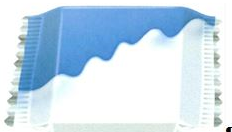10 mei 2016
Geen onderscheidend vermogen KNOPPERS achtergrond van verpakking

Gerecht EU 10 mei 2016, IEF 15933; IEFbe 1791; ECLI:EU:T:2016:284; T-806/14 (KNOPPERS)
EU merk. Beeldmerk bestaand uit een wit-en-blauwe achtergrond in vierkantgevormde verpakking. Het ontbreekt aan onderscheidend vermogen. Het Gerecht EU bevestigt dat oordeel. Voor bewijs was een survey overlegt die alleen in Duitsland was uitgevoerd.
8 By decision of 8 September 2014 (‘the contested decision’), the Fifth Board of Appeal of EUIPO dismissed the appeal on the ground that the mark applied for was devoid of any distinctive character in relation to the goods concerned within the meaning of Article 7(1)(b) of Regulation No 207/2009. First, the Board of Appeal upheld the Examination Decision’s finding that, on the one hand, the relevant public was the average EU consumer with a low level of attentiveness, and, on the other hand, the mark applied for consisted merely of a combination of presentational features that are typical of the packaging of the goods concerned. Furthermore, the applicant did not demonstrate that the colours or other decorative patterns included in the mark applied for would indicate the origin of the goods concerned. Second, the Board of Appeal observed that the applicant’s reference to the importance of colour-codes used by other manufacturers was irrelevant. Third, the Board of Appeal took the view that the results presented by the applicant, concerning a public survey carried out by Ipsos GmbH in Germany in April 2014 on the level of distinctiveness of the mark applied for, did not make it possible to establish such distinctiveness across the entire European Union. Fourth, the Board of Appeal found that the Examination Division was correct in noting that, as regards three-dimensional marks, the more closely the shape for which registration is sought resembles the shape most likely to be taken by the goods in question, the greater the likelihood of the shape being devoid of any distinctive character for the purposes of Article 7(1)(b) of Regulation No 207/2009. In that regard, the Board of Appeal concluded that the mark applied for was insufficiently distinguishable from other shapes present on the market for it to be regarded, in the absence of other fanciful elements, as having the minimum distinctive character required.
54 In any event, as the Board of Appeal rightly held at paragraph 17 of the contested decision, neither the scope nor the extent of the survey is appropriate to establish the mark’s distinctiveness in respect of the European Union. The survey was restricted solely to Germany, the country in which, furthermore, the applicant is established and which corresponds to its domestic market. The relevant consumer to be taken into consideration in the course of an assessment of the distinctive character of the mark applied for is that of the entire European Union (see, to that effect, judgment of 25 September 2014 in Peri v OHIM (Turnbuckle shape), T‑171/12, EU:T:2014:817, paragraph 45).
57 It follows from all the foregoing that the Board of Appeal was fully entitled to uphold the decision of the Examination Division and refuse registration of the mark applied for on the basis of Article 7(1)(b) of Regulation No 207/2009.






















